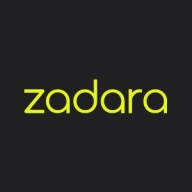


Hitachi Virtual Storage Platform (VSP) and Zadara compete in the storage solutions category. Users express satisfaction with Hitachi VSP's reliability and performance, but Zadara's flexible pricing model and cloud capabilities give it an upper hand.
Features: Hitachi VSP is praised for its scalability, high performance, and robust data protection features. Zadara offers versatile cloud integration, a pay-as-you-go model, and flexible deployment options.
Room for Improvement: Hitachi VSP could benefit from simplified setup, better documentation, and more training resources. Zadara needs enhanced support response times, more extensive on-premises options, and improved customer service quality.
Ease of Deployment and Customer Service: Hitachi VSP requires significant IT expertise for deployment and offers adequate but limited customer service. Zadara features a user-friendly setup and flexible deployment models, but its customer service receives mixed reviews regarding responsiveness.
Pricing and ROI: Hitachi VSP involves higher initial setup costs, resulting in long-term ROI through reliability and performance. Zadara's pay-as-you-go model offers lower upfront costs, leading to faster ROI for cost-conscious businesses.
By opting for the gold subscription every three years, you get a free upgrade to the latest controller release.
If you wait more than seven years to buy another one, you get a return on your investment.
While performance, security, and financial aspects of Hitachi Virtual Storage Platform are satisfactory, I am unsure about the exact return on investment.
The cost is not cheaper compared to AWS, and we have not seen the expected return on investment.
We also had one outage where a controller of one of the products had failed and had to be replaced on-site.
Customers always have their issues resolved promptly.
Pure has good storage.
The time taken to act upon issues is quite large, and issue identification takes a significant amount of time, especially when it comes to critical problems.
We lack adequate response times and a 24/7 service level agreement.
I rate the technical support from Zadara as nine out of ten.
It is highly scalable.
It is suitable for both medium-sized and enterprise businesses.
It hasn't broken down anytime in the last six to seven years, despite hurricanes, earthquakes, and power outages.
Zadara is a fully-fledged platform, and our customers are happy with its use.
During the eight years, there have been no problems such as hardware failure or stopping.
I would rate the stability of the solution as a ten out of ten.
I would rate the stability of the product at seven out of ten.
If we are running on a standalone infrastructure, I would rate Hitachi Virtual Storage Platform a 10 for stability.
We would appreciate a built-in transparent failover in the next release to eliminate the need for a separate metro cluster.
I'm eagerly anticipating the roadmap's promise of introducing multiple controllers, which could significantly boost scalability and resilience.
We mostly rely on long-term releases. We don't need the most up-to-date features, but we need a reliable environment.
The interface management and monitoring need improvement.
Adding AI capabilities could enhance the offering as well.
Maintenance can also be complicated, especially when deeper troubleshooting requires navigating the CLI and searching for logs.
While the prices may be higher than those of other vendors, we see it as a market leader with benefits.
The support can be a bit pricey, but the solution is more cost-effective than anything else out there.
I would give it a nine out of ten in terms of costliness.
The cost of Hitachi Virtual Storage Platform is reasonable compared to competitors.
The pricing is considered expensive.
Pure Storage has signature security technology, which cannot be deleted, even if you are an administrator.
The platform's robust features include excellent sustainability tracking, and a comprehensive dashboard offering insights into IOPS, bandwidth, performance, and virtual activities.
Its data compression feature is the best that we have ever seen.
The active data management of Hitachi Virtual Storage Platform, especially with the HOPS Center, makes it easier to work with the Hitachi Virtual Storage Platform infrastructure.
The most valuable feature is its storage management capability.
Zadara's troubleshooting feature is very valuable for me.
| Product | Market Share (%) |
|---|---|
| Hitachi Virtual Storage Platform | 3.4% |
| Pure FlashArray X NVMe | 1.0% |
| Zadara | 0.3% |
| Other | 95.3% |



| Company Size | Count |
|---|---|
| Small Business | 15 |
| Midsize Enterprise | 11 |
| Large Enterprise | 12 |
| Company Size | Count |
|---|---|
| Small Business | 19 |
| Midsize Enterprise | 14 |
| Large Enterprise | 28 |
| Company Size | Count |
|---|---|
| Small Business | 12 |
| Large Enterprise | 3 |
Pure Storage FlashArray//X is the world’s first enterprise-class, all-NVMe flash storage array. It represents a new class of storage – shared accelerated storage, which is a term coined by Gartner – that delivers major breakthroughs in performance, simplicity, and consolidation.
RETHINK YOUR DEFINITION OF SPEED AND PERFORMANCE
With adaptive, guaranteed data reduction and a 100% data-availability guarantee, Hitachi Virtual Storage Platform F series helps you tackle complicated business challenges. Hitachi Data Systems (HDS) VSP F series delivers up to 4.8M IOPS with sub-millisecond response times.
Featuring legendary Hitachi reliability, VSP F series arrays are backed by the industries only 100% availability guarantee. For these reasons, 80% of the Fortune 500 choose Hitachi all-flash arrays to accelerate the performance of mission-critical applications like Oracle, SAP, Virtualization, Microsoft apps etc. With over 350 patents in flash technology, Hitachi’s innovative mix of flash hardware and software accelerates ROI with enterprise-class reliability and performance.
Zadara is a powerful enterprise-level storage solution whose design enables it to handle every aspect of a user’s data storage needs. It can be deployed in any location, using any protocol, and storing any data type that an organization requires. With Zadara, organizations can do everything that they were able to do with more traditional systems in a cheaper and more efficient way.
Zadara Benefits
Some of the ways that organizations can benefit by choosing to deploy Zadara include:
Zadara Features
File analytics. Organizations can leverage a powerful analytics package that can provide them with critical insights. These tools can help users sort through their data and make more informed data management decisions.
Reviews from Real Users
Zadara is a highly effective solution that stands out when compared to many of its competitors. Two major advantages it offers are its extensive suite of cloud solution integrations and its object storage capability.
Steve H., the chief technology officer at Pratum, writes, “One of the most valuable features is its integration with other cloud solutions. We have a presence within Amazon EC2 and we leverage computer instances there. Being able to integrate with computing, both locally within Zadara, as well as with other cloud vendors such as Amazon, is very helpful, while also being able to maintain extremely low latency between those connections.”
Mauro R., the CEO of Momit SRL, says, “The object storage feature is wonderful. With traditional storage, you have a cost per gigabyte that is extremely high or related to the number of disks. With Zadara Storage Cloud, you have a cost per gigabyte that you can cut and tailor to your needs independent of the number or size of the disks.”
We monitor all All-Flash Storage reviews to prevent fraudulent reviews and keep review quality high. We do not post reviews by company employees or direct competitors. We validate each review for authenticity via cross-reference with LinkedIn, and personal follow-up with the reviewer when necessary.